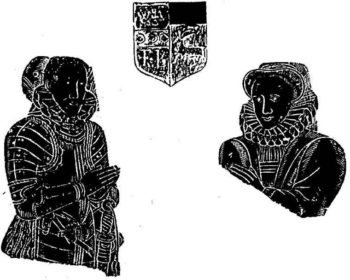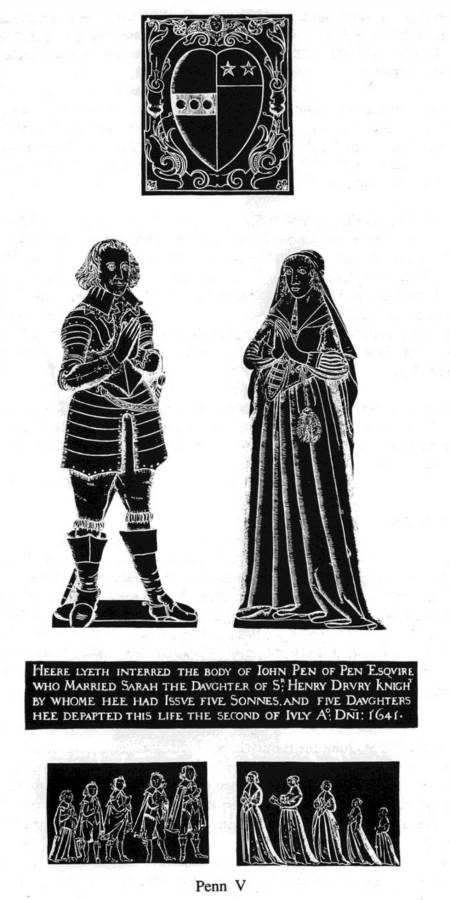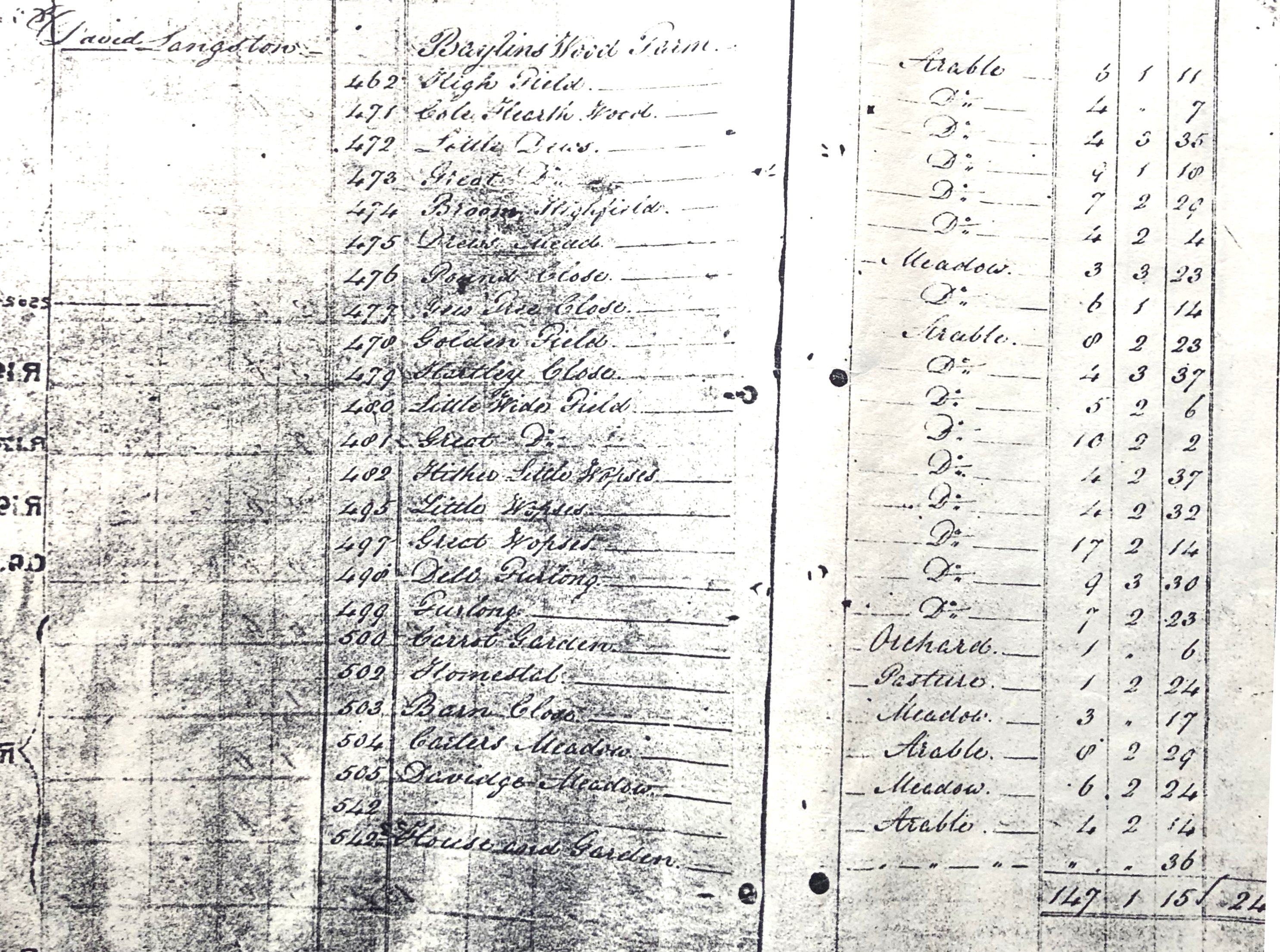Part of the Penn/Curzon Estate
The documents concerning the sale of Baylins Farm by Andrew Windsor to John Penn in 1593 give detail of the scope of the farm at that period. It was described as ‘the manor of Beelinges otherwise Byllynges with appurtenances and of one messuage, one garden, one orchard, 200 acres of land, six acres of meadow, twenty acres of pasture, twenty acres of wood, twenty acres of furze and heath, and 4/0 rent with appurtenances in Penne.’ This was the property that would form part of the Penn/Curzon/Howe Estate for the next 400 years.[1]
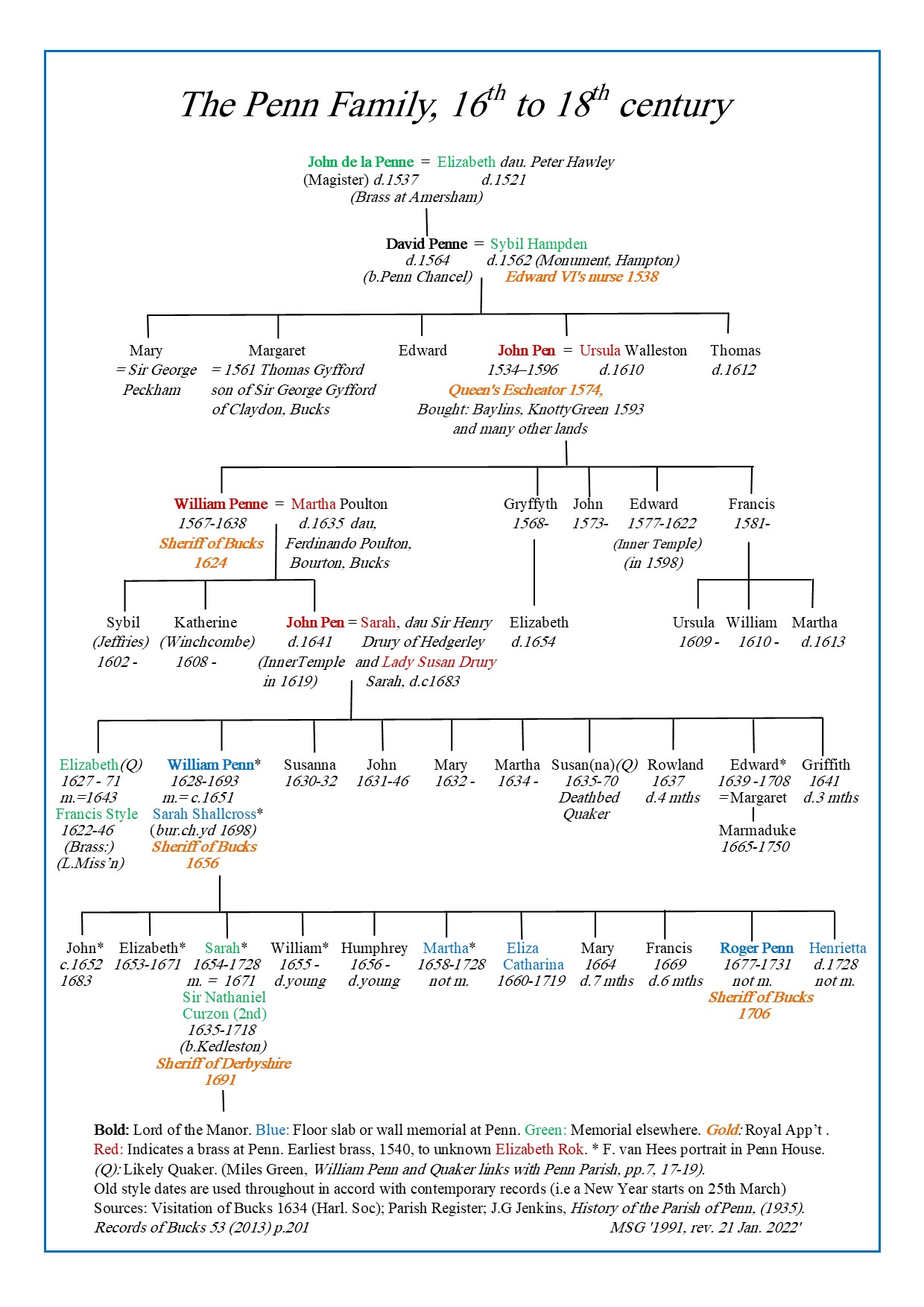
View as PDF – opens in new window
Just three years later John Penn died in 1596 and was buried in the chancel at Penn Church on 12 October. His widow Ursula survived him until May 1610 when she in turn was buried in the church and they are both commemorated with a brass memorial. The Penns had clearly remained Catholic in their sympathies as in 1584 they were listed as absentees at a time of compulsory church attendance and the following year Ursula agreed to pay a fixed annual fine towards providing horses for the Queen’s service in return for exemption from penalties to which they were liable for their recusancy. Their links to the Royal family may have protected them from more unpleasant consequences. John’s mother Sybil Penn had been foster mother to Queen Elizabeth’s younger brother who became Edward VI. Henry VIII, Edward VI and Elizabeth all gave Sybil Penn gifts, land and an annuity. This contrasts with the treatment of the Lord of Segraves Manor in Penn who was imprisoned in 1587 for aiding and sheltering catholic priests.
John himself had been appointed Elizabeth’s Escheator for Bedfordshire and Buckinghamshire in 1574. This seems to have been a lucrative function as he was able to buy other properties besides Baylins in the last quarter of the C16th.
John Penn’s eldest son was William (1567-1638) who, having grown up in a Catholic household, married Martha Poulton who was also catholic. He was 29 years old when he inherited the enlarged estate and became Lord of the Manor. In later life he was sufficiently well thought of to be appointed Sheriff of the County in 1624. William and Martha had one son, John, and two daughters, Sybil and Katharine.
This latest John Penn was born c. 1595 not long before the time of his grandfather’s death. He married Sarah, daughter of Sir Henry Drurey of Hedgerley, and they had ten children, five boys and five girls. They must have married c. 1626 as their first daughter was born in 1627 and it seems reasonable to speculate that Baylins Farm became their family home at this time. His mother and father occupied Penn House and the young couple would have needed a sizeable home although three of the ten children are known to have died young.
We know that Richard Ognell, who occupied Baylins Farm when it was purchased by John Penn senior in 1593, died in 1618 and that William Penn was his sole executor. He had no children. David and George Grove witnessed the will. Apart from legacies to various family members he left £5 to the poor of Penn and £3 to the poor of Beaconsfield. He had four servants (3 men, 1 woman) to whom he left 40 shillings each[2]
The same year, 1618, William Penn paid 20 shillings to King James for the grant of all the timber and free fishing for ever ‘in his manor or lordship of Penne lying and being in the towns and parishes of Penne, Woodburne and Wicombe in our county of Buckingham, and his manor of Seygraves lying and being in Penne, and in his manor or farm commonly called Beelings lying and being in Penne, and in his farm commonly called Le Parsonage in Penne.” Also included in the grant was Beamont manor and Affricks farm in Little Missenden as well as a farm in Nether Orton, Oxfordshire.[3]
In 1627 William agreed to convey “by fine or feoffment” the “manor, capital messuage, tenement and farm with the appurtenances being within the parish of Pen called Bealings” to Trustees subject to an annuity of £200 to be paid his son Jon Penn and his wife Sarah during his lifetime. Following his death it would pass to John and Sarah and their descendants.[4]
It is known that much work was carried out at the house around this period. The exterior was clad in brick to hide the timber frame and the daub-and-wattle in-fill panels. An extension was built to provide a room on the east side that became a larder and a new wide staircase was installed for access to the first floor.
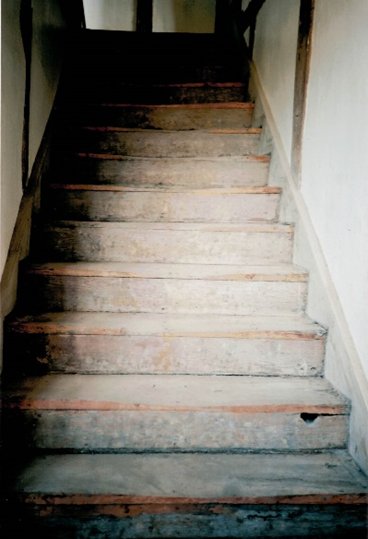 A room downstairs was panelled with oak wainscot to provide a snug drawing room. Two large oak doors which have been dated by their ledged planks and strap hinges to between 1590 and 1640 were evidently installed at the same time and are particularly interesting because they have taper burn marks on them which are understood to be connected with Catholics continuing to practice within their homes when expelled from the church. Similarly the salt niches in the fireplace are likely to have been used to display significant spiritual objects ‘as a personal badge of affiliation to Catholicism’.[5] In view of the Penn family’s catholic tendencies at the time this serves to reinforce the view that the house was modified around 1626/7 to provide a comfortable home for the newly married John and Sarah Penn.
A room downstairs was panelled with oak wainscot to provide a snug drawing room. Two large oak doors which have been dated by their ledged planks and strap hinges to between 1590 and 1640 were evidently installed at the same time and are particularly interesting because they have taper burn marks on them which are understood to be connected with Catholics continuing to practice within their homes when expelled from the church. Similarly the salt niches in the fireplace are likely to have been used to display significant spiritual objects ‘as a personal badge of affiliation to Catholicism’.[5] In view of the Penn family’s catholic tendencies at the time this serves to reinforce the view that the house was modified around 1626/7 to provide a comfortable home for the newly married John and Sarah Penn.
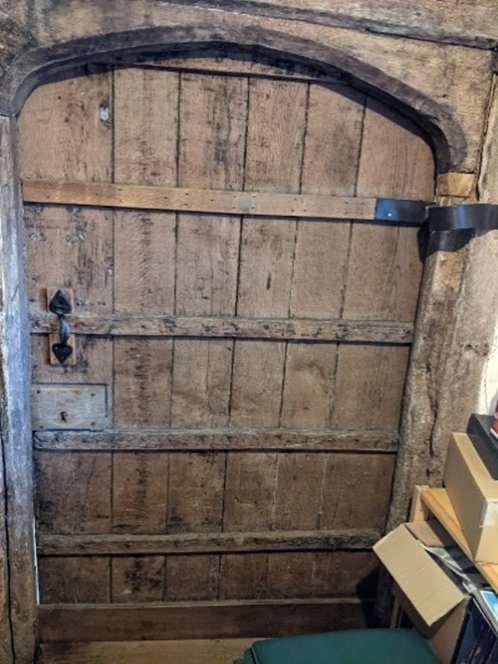 The application of taper burns to beams within the house is however evidence of an older tradition that must pre-date Penn family ownership and the installation of these two doors. Burn marks can be found on the original timber frame of the house in twelve different locations and in many instances were applied repeatedly. The absence of burn marks in the first floor above the hall, in contrast to all the other rooms on the first floor, implies that it was a ritual that was practiced prior to 1563 (the installation date of the hall ceiling) and thus probably part of an older tradition of apotropaic signs that might protect against lightning, fire or ward off evil spirits.
The application of taper burns to beams within the house is however evidence of an older tradition that must pre-date Penn family ownership and the installation of these two doors. Burn marks can be found on the original timber frame of the house in twelve different locations and in many instances were applied repeatedly. The absence of burn marks in the first floor above the hall, in contrast to all the other rooms on the first floor, implies that it was a ritual that was practiced prior to 1563 (the installation date of the hall ceiling) and thus probably part of an older tradition of apotropaic signs that might protect against lightning, fire or ward off evil spirits.
John’s father William Penn died in 1638 and John only survived him by four years until 1641. In his will he bequeathed the manor of Bealings to his wife Sarah as dower. His son and heir William Penn was only 12 years old so was a ward of the Crown until he was 21 so all profits from the estate were payable to the Crown. The inquisition post mortem recorded that “the said manor of Bealings was held of the King as of his Duchy of Lancaster in free and common socage and is worth by the year in all issues beyond reprises £5. 5. 0.”[6]
William Penn (1628-1693) married Sara Shallcross circa 1651 and it was their daughter Sarah Penn who married Sir Nathaniel Curzon (1640-1719) around 1700.
No information has yet emerged as to who occupied Baylins Farm in the latter part of the 17th century but it seems likely that by around 1700 the Penn family had installed tenant farmers to run the farm. We know that in 1754 George Salter paid a Poor Rate for Bailings and in the same year a Mrs Salter of Bealings was buried as was Hannah Ranger,widow, of Bealings, and also that on 10 September 1759, Joseph, son of George Salter of Bealings, died. These mentions are the earliest positive links between the Salter family and Baylins. The Salters were an old Penn family with records of their births, marriages and deaths appearing in the Penn Church Registers in the last quarter of the 16th century. Edmond Salter was overseer for the poor in 1627 and churchwarden from 1631 to 1633. A George Salter was churchwarden in 1715 when the clock was installed.[7] He and his wife Martha were the parents of the George Salter, (later described as Yeoman of Bailings, Penn), baptized 4 August 1711, who died in 1788 aged 77 years and was buried at Penn Church. In his will he gave and bequeathed ‘unto my dear wife Sarah Salter all the bed bedding and also two pair of my best sheets draws chairs and all other furniture except one pair of chest of draws in the yellow papered room wherein I now usually lie’. He also referred to ‘my copyhold messuage…in the manor of Seagraves…now in the occupation of Miss Isham.[8] Sarah ‘relict of George Salter of Baylins’ lived on until 1808.
Confusingly we know that in 1718 Thomas Winter, who was described as a yeoman of Beelings in the parish of Penn, apprenticed his youngest son John to Alexander Daniel, surgeon of Beaconsfield, for seven years for 10 guineas to learn ‘the art of surgery and all the practice in … setting bones, bleeding, tooth drawing, dressing of wounds, imputacons’ etc.[9] His children were baptized in Penn between 1680 and 1699 but when Thomas died in 1722 he was then a ‘yeoman of little Missenden’ having remarried there in 1718 and so no longer from Baylins.
The next references we have are the Posse Comitatus, which shows William Winter at Baylins in 1798, and the following year when his widowed daughter Mary Allen (née Winter) married Thomas B. Bovingdon of Glory Farm.[10] This William was a son of John the surgeon
By 1810 John Boucher was the farmer and Bailings was assessed at £78 15s for the Poor Rate Book. After Boucher the Langston family became tenants. In 1836 Thomas Langston, farmer of ‘Beylings Farm’, Penn, made his will stating he was ‘weak in body but of sound mind’ and left everything to his brother David Langston ‘now of Baylins Farm’.[11] At the 1841 census David Langston, by then 60 years old, and his two elder brothers, Thomas and Richard, were in occupation. David, his wife and three servants were living there at the 1851 census and he stayed until he died in 1855 leaving everything to his wife Sarah and then to his brother William.[12]
From 1838 we have the details of the Tithe Award Map which recorded the names and acreage of the fields that David Langston was farming at that time. This came to a total of 147 acres, most of which was arable with only 20 acres described as Meadow, pasture and orchard. It excludes any woodland which presumably made up the difference to the amount of land acquire by John Penn in 1593. The farm stretched from Saucy Corner in the North down to the Forty Green Road in the South and went Westwards to Saunderswood.[13]
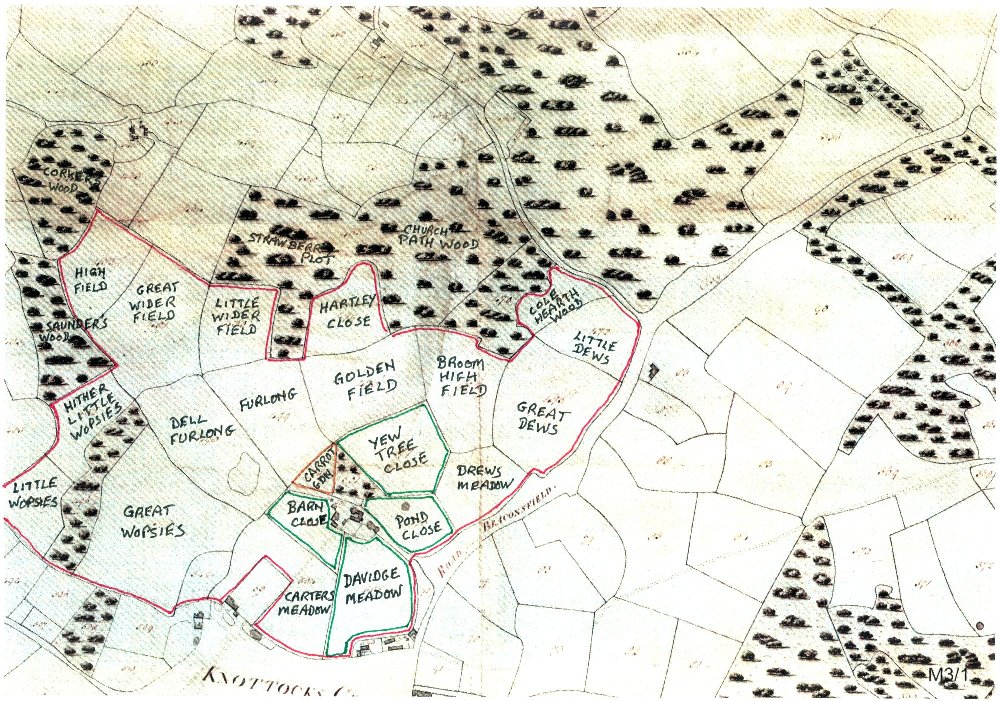 The field names are fascinating such as Great & Little Wopses and Golden Field.
The field names are fascinating such as Great & Little Wopses and Golden Field.
See also Baylins Farm Field Names Click on Image to enlarge to screen width …
Baylins Entry in 1838 Penn Tithe and Map
Click on Image to enlarge to screen width …
The next tenant was William Redding who, with his wife, 1 daughter and 4 sons, was at Baylins Farm when the 1861 census was taken (he was Church Warden at Penn in 1859). He was then aged 35 years and managed 140 acres. Ten years later he was still there and had 2 daughters and 5 sons. The farm had 160 acres, employed 3 labourers and 2 boys as well as a live-in servant Joseph Allen who was 14 years old. Redding’s tenancy terminated on 29 September 1875 and he was succeeded by William and John Priest. But there was no mention of John Priest at the time of the 1881 census but we know that a John Priest was buried at Penn in 1882 with his wife Susannah who had died in 1876. The census records William Priest (38) with wife Eliza (40) and 3 sons (aged 4,3 and 2 yrs) and a 1 year old daughter. They were still farming 160 acres with 3 men and a boy and had three young indoor servants. However there was also a brother of William called John Priest who farmed in Little Missenden where he died in 1899.
Also recorded under Baylins Farm in the 1881 census were Arthur Tapping, Thomas Bryant, John James, William Carter, all agricultural labourers, and all of whom were living with their own wives and families. There was also John Lane retired gamekeeper and Edward Tilbury a brick layer, with their families. One has to assume they lived in cottages around the farm and not in the farmhouse.[14]
In 1896 when the tenancy was renewed again it was in the name of William Henry Priest alone who stayed on with his wife, Eliza, a member of the Salter family, and five children. William continued to run the farm until he died in October 1917. His wife and family were allowed to stay on until the end of September 1919.[15] Their eldest son, William George Priest, who was born at Baylins Farm in 1876, grew up to be a farmer at Farnham Royal but later emigrated to Kyogle in New South Wales, Australia, where his family lived in a house named Baylins. Another son, Ernest Arthur (1878-1942) married Alice Louisa Redding.
[1] Feet of Fines. Bucks, Easter. 35 Elizabeth. Extract copied by Richard Holworthy 1924.
[2] Bucks wills vol. for 1618/19 folio 92. Transcribed by Richard Holworthy 1924. Viewed at County Records Office by OSH, 19.01.2001. ref We27125, Wf22287. Noted ‘brass pot bought off my sister Elizabeth.’
[3] Patent Roll 2171. No. 3. 16 James 1. Part 7. Transcribed by Richard Holworthy, 1924.
[4] Chancery Inquisition post mortem. Series II. Vol. 602. No. 63. Transcribed by Richard Holworthy, 1924.
[5] Information from Dr Jonathan Duck 23.11.2021. who has researched the subject and spotted the burn mark from a photograph. See his articles How to Protect your Home from Evil, Listed Heritage Magazine, March/April and May/June 2022.
[6] Chancery Inquisition post mortem. Series II. Vol. 613. No. 67. Transcribed by Richard Holworthy, 1924.
[7] Notes taken from the Penn Registers by Ambrose and Edith Heal in 1920. From a 1748 document acquired by Ambrose Heal which gave details of General Fuller’s estate at Gregorys, Beaconsfield, we know that ‘Davenies Farm, consisting of a farmhouse and about 144 acres of land & meadow ground’ was in the tenure of George Salter and the rent was £75.00 p.a.
[8] George Salter, Bailings, Penn, Yeoman. Will dated 26.05.1787, proved 22.08.1788. County Records Office D/A/We/112/47 D/A/Wp/104/2350.
[9] Apprenticeship Indenture 26 March 1718. Ref: D209/137 (via Susan Cooper).
[10] Miles Green and Susan Cooper letters 2007.
[11] County records Office D/A We/147/2. D/A/Wf/122/125. Although dated 9 May 1836 the will was not proved until 4 Jan 1851.
[12] County Records Office D/A/We/148/45. D/A Wf//123/89. Will 24.08.1853, proved 11.04.1855.
[13] Information kindly supplied by Miles Green.
[14] My thanks to Debbie Marsden for the information in the censuses
[15] Dates of tenancies provided by Mr Widdowson to Ambrose Heal.
Oliver Heal, January 2024

